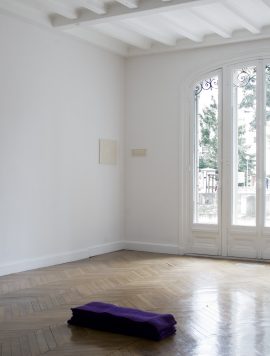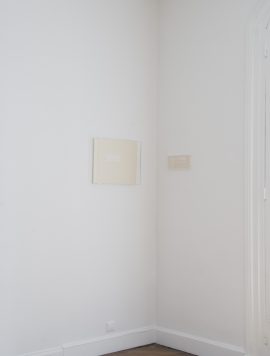Jason Dodge
My initial encounter with Jason Dodge’s work came via a reproduction in a leaflet of Above the weather in 20051. The heap of string, wire, rope, electrical cord and other items reminded me of a series of measurement works by Stanley Brouwn which had marked my relationship to art – with the difference that its title let me foresee a practice at the crossroads of a conceptual approach and a certain romanticism. I could perceive its reality and its abstraction, its banality and its sublimity. It was at once simple and complex.
The first time I actually saw a Dodge piece, it was Above the weather again – but another version, in Paris2. Although I had seen it before, its familiarity didn’t diminish its power of evocation. Dodge makes a work several times in different versions and this doesn’t bother me. I even appreciate the feeling of seeing the same / different thing two or three times; like a time loop, it alters my relationship to reality. All it requires is a proper look at a work of art. More than the tiny changes one can notice, the process of its making gives it a uniqueness. Not ostentatiously, though: this is a whispered process. Like Darkness falls on Wolkowyja 74, 38-613 Polanszyk, Poland, it tells a story that has already taken place but which continues through my experience of it.
Dodge’s works appeared to me first in their objectival dimension. Rather than seeing them as readymades, I could relate them to still life and to a poetic materialism comparable to Francis Ponge’s poetry. I still apprehend them as condensed objects which, although reduced and contained, mentally suggest expansion. As a metaphor for the idea of unwinding, the woven tapestry also titled Above the weather has helped me to “read” many other works. Through their very physicality, these works induce mental displacement. I can project my imagination onto them just as naturally as they call to my imagination. Made explicit in the use of homing pigeons, travel also appears in the presence of light acting as a conductive material and in the idea of sound (bells, viola strings) as a way of extending visual perception.
I suppose these signs of displacement had always been present in the work, but I didn’t really pay attention to them before. In 2007 in Paris, the poison hemlock gold shaft installed beneath a wall between two rooms shifted my attention from objects to the space in-between3. The work, comprising a thin conductive element whose content was invisible, seemed to permeate the whole space. I began to look at the same works differently, noticing more than before air, electricity, water and heat. The circulation of air was visible in the wind instruments, just as it could be halted by a blocked flute. I started to notice more conduits, flues, tubings, pipes and other things which may suggest flow or a lack of it. Vital functions seemed to be the actors of this fluidity, such as the broken furnace and the copper pipes connected to water4.
In parallel with this evolution, the more the circulation between things was visible, the more the objects became anomalously associated. I could not immediately explain a pigeon egg on a gold ring, a flute under a sleeping bag, or the word “violin” attached to trousers. Although as visual as before, Dodge’s work seems to have built a syntax of its own, composed of objects (words) and conductive elements (link-words). Two bells keep the poster Alphabet five generations of bell makers Nürnberg folded and its text unreadable. Yet, when one tries to open it, the sound they produce creates the missing sentence that links the letters.
Marianne Lanavère
Translated by John Tittensor
1. Ticker 9, group exhibition curated by Aurélie Voltz, Carlier Gebauer, Berlin, 2005
2. Some Time Waiting, group exhibition curated by Adam Carr, Kadist Art Foundation, Paris, 2007
3. Jason Dodge, solo exhibition, Yvon Lambert, Paris, 2007
4. Jason Dodge, I woke up. There was a note in my pocket explaining what had happened, solo exhibitions, Casey Kaplan, New York, 2009 and Kunstverein Hannover, 2010
around the exhibition
-
05/06/2010
From 5:00 to 6:30 pm
Reading / concert: “Metamorphoses”
Variations from the Metamorphoses, Benjamin Britten’s work for oboe (1951).
In partnership with the oboe classes from I. Dupré and R. Rudolf’s Digital Music Production at the Noisy-le-Sec Academy of Music and Dance, and with S. Teyssier and G. Vanoudenhoven, artists. -
12/06/2010
3:00 pm
East Trail #1 : Bus visit to the exhibitions at Instants Chavirés (Montreuil), at Khiasma (Les Lilas), and at La Galerie. -
26/06/2010
From 6:30 to 9:00 pm
Contemporary American and French poetry reading. -
17/07/2010
Summer book party:
To celebrate the catalogues co-published by La Galerie in 2009–2010, screenings, discussions and more.




